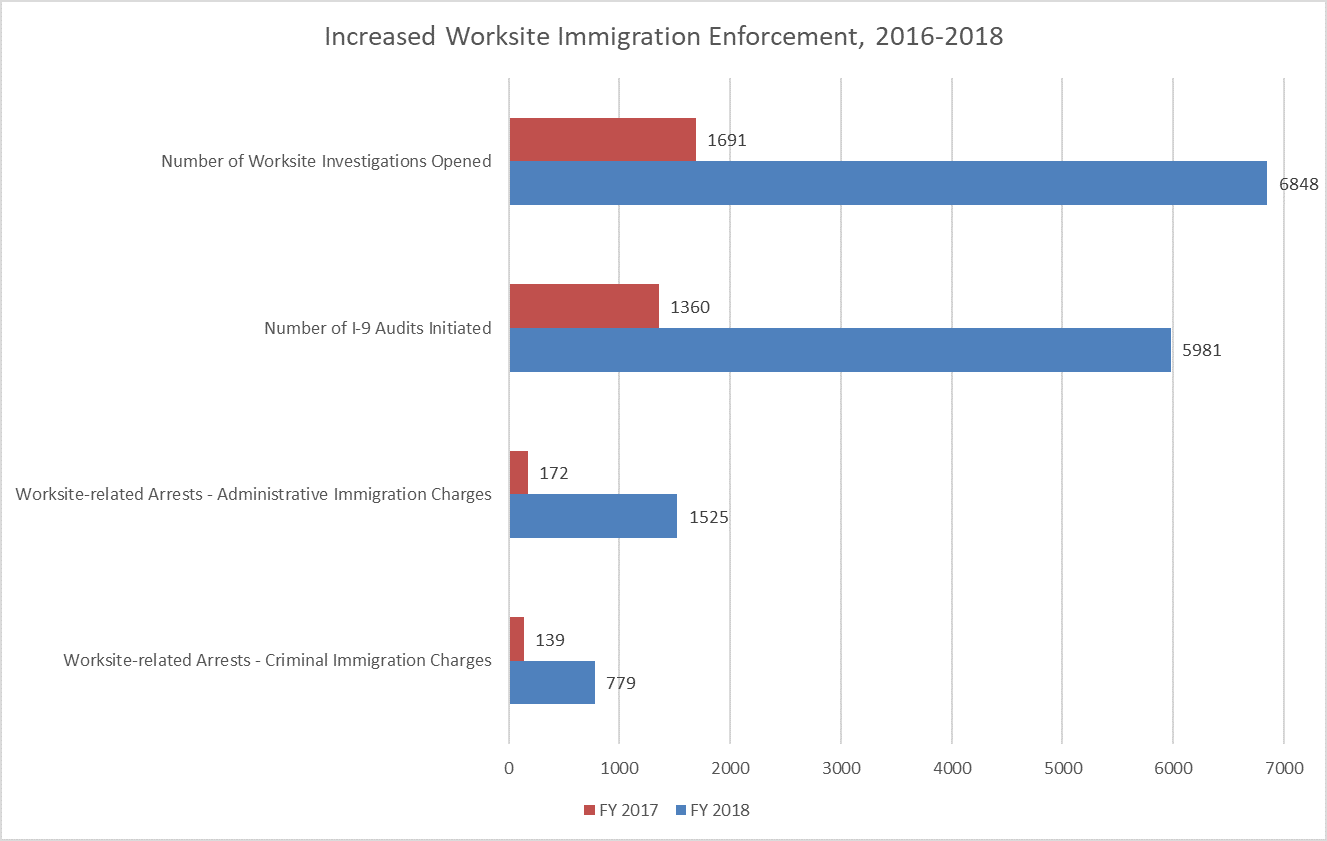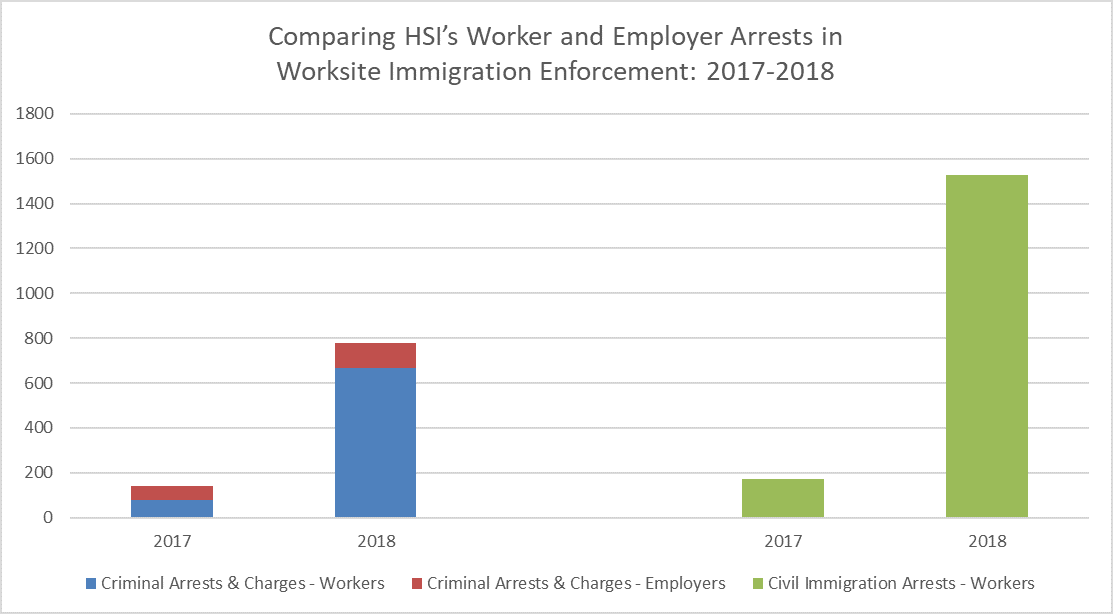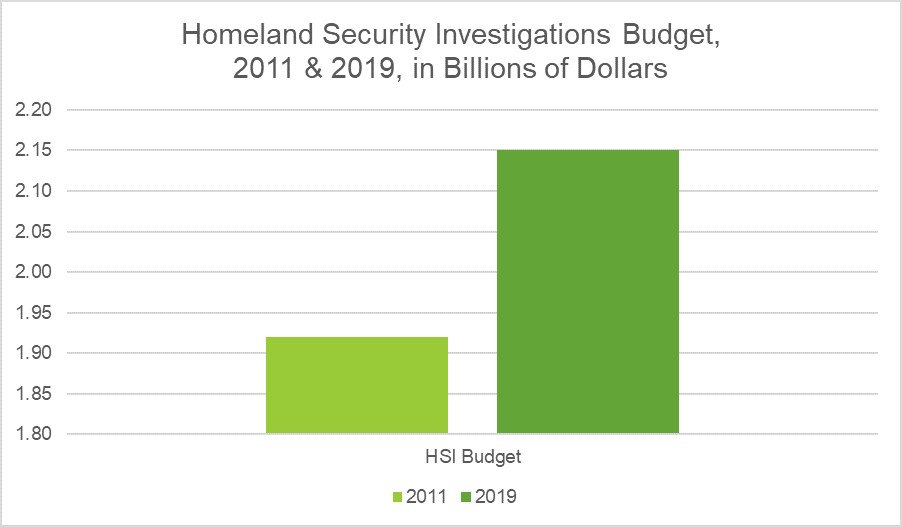Prepared by the Immigrant Legal Resource Center, the National Immigrant Justice Center, and the National Immigration Law Center
Download this backgrounder as a PDF.
I. Homeland Security Investigations (HSI): An Overview
As the Trump administration’s aggressive immigration policies have increasingly come under scrutiny, Homeland Security Investigations (HSI), a division within the U.S. Department of Homeland Security (DHS), has played an increasingly significant role in carrying out brutal tactics to target immigrants for deportation.
HSI was created in 2010 as a division within DHS’s law enforcement arm, U.S. Immigration and Customs Enforcement (ICE). With a stated mission of investigating cross-border criminal activity, HSI took over the role of ICE’s preexisting offices of investigations, intelligence, and international affairs. HSI has 26 field offices nationwide, with various divisions that handle a range of criminal investigations in the U.S. and overseas. Those criminal investigations include: financial crimes; bulk cash smuggling; cybercrimes; child exploitation and child sex tourism; weapons smuggling/export enforcement; trade crimes (i.e., commercial fraud and intellectual property theft); human smuggling and trafficking; narcotics smuggling/trafficking; identity/benefit fraud; human rights violations; transnational gang activity; counterterrorism; and visa security.
According to ICE’s website, HSI’s role is intended to be distinct from that of ICE Enforcement and Removal Operations (ERO), which handles interior enforcement of civil immigration laws. However, as it stands today, HSI’s mission has increasingly focused on carrying out the Trump administration’s harsh and often unlawful enforcement-only approach to migration. Particularly as ICE’s leadership has encouraged street-level officers to abandon the use of prosecutorial discretion, HSI agents are increasingly complicit in round-ups fueled by racial profiling, sham investigations that purport to involve child welfare but are intended to create fear among children’s loved ones and sponsors, and increased aggressive workplace raids that leave communities traumatized.
II. How HSI Creates Pipelines for Trump’s Mass Deportation Force
Although HSI’s primary legal authority is for investigating cross-border criminal activity, HSI has more recently been linked with increased worksite enforcement activities emanating directly from Trump administration directives. In 2017, ICE’s then acting director, Tom Homan, instructed HSI to increase its investigations of worksite immigration violations by “by four to five times.” As a result, not only has HSI increased its worksite enforcement activities, but, in light of changed policy during the Trump administration, the subagency has been conducting enforcement against workers as well. HSI enforcement actions have also raised serious concerns over the use of racial profiling to make overly broad and vague allegations against immigrant youth of color during investigations into gang-related or other criminal activity. In late 2017, for example, CBS News highlighted these abuses when a reporter “rode along” for a predawn raid targeting a supposed gang member. The HSI agent conducting the operation readily admitted to the reporter that “the only known crime the suspect had committed was being undocumented.”
Other recent reports have also revealed HSI’s alarming involvement in surveilling journalists, lawyers, and advocates reporting on or working with migrants near the U.S.-Mexico border, as well as tracking advocates who have engaged in “anti-Trump” activities and creating dossiers on them in secret databases. In some instances, this surveillance has led to concerns of retaliation by DHS, with alerts being placed on passports and several individuals being detained for hours, interrogated by U.S. Customs and Border Protection (CBP), and prevented from traveling internationally.
Despite growing evidence of HSI going beyond its mandate and engaging in massive immigration sweeps, HSI continues to insist that its role is distinct from that of ICE ERO. HSI leadership has even gone so far as to request that HSI be separated from ICE altogether in an effort to distinguish itself from ERO’s focus on targeting noncitizens for deportation, claiming, “The perception of HSI’s investigative independence is unnecessarily impacted by the political nature of ERO’s civil immigration enforcement.”
HSI’s mission creep is exacerbated by the fact that the Trump administration has abandoned the use of prosecutorial discretion in immigration enforcement, broadening the range of immigrants targeted for enforcement to include all undocumented immigrants, and has explicitly encouraged a climate of fear in immigrant communities. As a result, ICE officers — ERO and HSI — are now directed to more broadly track down, arrest, detain, and deport anybody suspected of violating immigration laws, with little oversight or accountability.
We have already seen the impact such changed priorities have had. White House requests for additional funding to increase the number of ICE — and, in particular, HSI — agents, combined with Homan’s statements that worksite enforcement will increase four to fivefold, would result in an even greater spike in the arrest, detention, and removal of immigrants for solely civil immigration violations simply because they are part of HSI’s investigations dragnet, even when they are not the intended criminal target.
A. HSI Engages in Rampant Racial Profiling
Rather than “combating terrorism and enhancing national security,” HSI, as an enforcement arm of ICE, has sown fear and anxiety in immigrant communities by largely targeting and racially profiling individuals with little to no evidence or even reasonable suspicion of wrongful conduct. In 2018, HSI conducted approximately 3,635 arrests that it identified as “gang arrests” — but the reality is very different. One of the most notorious HSI initiatives is Operation Matador, started in 2005 as a collaborative initiative between ERO and HSI agents, U.S. Citizenship and Immigration Services (USCIS), and local law enforcement to target various gangs in Suffolk and Nassau Counties in New York. Under this initiative, HSI agents are given free rein to arrest an individual suspected of gang activity or affiliation based merely on the individual’s immigration status, even if there are no other concrete facts.
Once the word “gang” is attached to an individual, the ability to receive a fair chance at due process within an immigration court immediately and drastically shrinks. HSI agents, along with local law enforcement, issue memoranda that are included in an individual’s file, and although there is no evidentiary standard or burden of proof placed on ICE to establish gang affiliation as a negative discretionary factor in immigration court, such memoranda are shared with immigration judges. According to a recent survey of immigration practitioners representing young immigrants, reports or memoranda issued by HSI were among the most common types of evidence used to assert gang allegations. Additionally, not only do immigration judges rely on such documents during bond and custody determinations and hearings, the evidence-deficient memoranda are easily accessible by any agency within DHS, so that one’s immigration benefits or ability to travel internationally may be unfairly impacted.
It is no longer a secret that HSI agents use the “gang” label as a cover for engaging in widespread round-ups of immigrant youth of color. As one HSI agent stated, the “purpose of classifying [someone] as a gang member or a gang associate is because once he goes in front of an immigration judge, we don’t want him to get bail.” In such cases, an HSI agent will also recommend that the individual be denied any other form of immigration relief or benefit in the future. Often gang allegations are supported by vague or irrelevant details, such as the individual’s clothing or unreliable testimony from informants, and do not include critical information such as basic facts (i.e., when, where, or context) surrounding suspicious incidents. HSI memoranda have even included social media photos with vague and unattributed annotations to try to demonstrate support for the gang allegations. In immigration court, it is extremely difficult if not impossible for a young immigrant to refute such allegations.
In addition to the flimsy nature of evidence being used to support gang allegations, attorneys are faced with an alarming lack of transparency when it comes to the government’s assertions during immigration proceedings. When DHS relies on an HSI memorandum or DHS charging documents to claim an individual is a “‘verified’ or ‘known’ gang member … there is no information regarding how that determination was made” — which compounds the difficulty to refute the allegations.
Addressing gang violence is a complex issue requiring evidence-based solutions. Profiling youth of color living in already over-policed neighborhoods and other suppression tactics have not proven successful in reducing gang violence and have made children, including those going to school, a priority target. Real solutions to gang violence will not be found in more congressional funding for DHS but rather by investing in prevention, trauma-informed support services, and integration programs. Funding should be funneled to strengthen the skills and capacities of social support programs in local communities working directly with immigrant youth.
B. HSI’s Massive Workplace Raids Cause Long-term Community Harms
While HSI wants the public to think that it focuses primarily on national security and transnational crime, it is responsible for the ramp-up of worksite enforcement. Under Trump, ICE has vowed to increase worksite enforcement activities “4 to 5 times,” and it has resumed engaging in highly militarized and coercive large-scale worksite immigration raids. In fact, over the spring and summer of 2018, it conducted several high-profile operations in Florida, Tennessee, Iowa, two locations in Ohio, Nebraska, Minnesota, Texas, Arkansas, and North Carolina. Most recently, in April 2019, it engaged in the largest workplace raid in a decade, in Allen, Texas, arresting over 280 individuals.
Worksite raids are a violent and widely condemned enforcement tactic that tear parents away from unsuspecting children, cause profound psychological harm, destabilize local communities, and generally undermine all workers’ job-related rights. While HSI has attempted to legitimize its use of worksite raids by claiming they are criminal investigations, the vast majority of the workers detained are administratively arrested on civil immigration violations, and in most cases the employers are not criminally charged. If HSI focuses its efforts on workers and does not go after the employers who hire them and profit from their labor, many of these employers will not be deterred.

During the spring and summer of 2018, disturbing patterns emerged in HSI’s conduct of its worksite raids. Multiple news reports, and HSI’s own enforcement operation plan, described that while helicopters circled overhead and local law enforcement blocked nearby roads, HSI agents stormed worksites as heavily armed guards secured all exits. In the utter chaos that ensued, unsuspecting workers were subjected to excessive force, intimidated by police dogs, thrown to the ground, assaulted, had guns pointed at their heads, and were subjected to racist and degrading comments from HSI agents. In Ohio, plainclothes HSI agents initially lured a group of workers into a breakroom using boxes of donuts before surrounding them and arresting them. In multiple raids, HSI agents racially profiled workers, rounding up brown-skinned workers without asking for identification or immigration status information — which resulted in false arrests of U.S. citizens who were then held unlawfully, in some cases for hours. Other reports include forcing workers to segregate themselves based on their status and providing green wristbands to those with immigration status.
Predictably, such enforcement causes deep trauma to those directly impacted by it and also terrifies the larger immigrant community. After a devastating raid in Tennessee, the ripple effects spread across the region, with neighbors scrambling to care for children who had been left stranded without parents for hours and families sleeping in churches for days out of fear of ICE coming to their homes. The day after the raid, 550 children failed to show up to local schools. This kind of immigration enforcement has a profoundly destabilizing effect on the well-being of the children whose parents are unexpectedly torn from them, causing severe anxiety and depression, poor sleeping and eating habits, inability to focus in school, and constant fear of separation from other family members.
While HSI has engaged in criminal investigations of employers since its formation, the use of large-scale worksite raids to target workers for arrest and deportation was discontinued after 2008 due to the widely documented harms and the havoc these operations cause. In public statements, HSI has attempted to justify its increased participation in worksite enforcement as necessary to “build another layer of border security” and “reduce the continuum of crime that illegal labor facilitates.” In reality, HSI is making the decision to engage in the most aggressive, violent form of enforcement it can take at worksites because the real purpose of the raids is to target workers for deportation while creating a media spectacle designed to intimidate immigrant communities into “self-deporting.”

If HSI were serious about curbing unlawful hiring and employment, it would focus its resources on pursuing employers who are suspected of criminal activity. Yet in the majority of recent raids, employers have not been charged criminally — in fact, 2018 saw the lowest number of federal indictments and convictions of managers for unlawful hiring offenses in the last 10 years. In addition, of the 779 criminal worksite arrests that HSI did make in 2018, 85 percent were of workers and 15 percent were of employers. As the graph above shows, in the last year HSI has expended far greater resources in pursuing criminal charges against workers — usually for nonviolent unlawful reentry charges unrelated to the criminal investigation that prompted the raid and only identified after HSI took the workers into custody and fingerprinted them (see examples from the raids in Tennessee and in Sandusky and Canton, Ohio).
HSI also claims that its investigations help combat the exploitation of workers, but that couldn’t be further from the truth. HSI’s worksite enforcement activities force immigrant workers into the margins and damage communities, making workers more fearful of deportation and more vulnerable to gross exploitation by employers. When HSI’s own investigation of the Tennessee employer turned up wage-and-hour and safety violations on the job, it did not refer those violations to the proper authorities (who opened investigations only after the employees filed complaints).
ICE has been sued repeatedly for constitutional violations committed during home raids, and it should be aware of the constitutional rights and protections that everyone in the U.S. has. Should it have doubts, ICE should consult with DHS’s Office of Civil Rights and Civil Liberties.
C. HSI’s Anti-Trafficking Work
U.S. laws define severe forms of trafficking in persons as both a commercial sex act induced by force, fraud and coercion as well as the recruitment, harboring, transportation, provision or obtaining of a person for labor or services through the use of force, fraud or coercion for the purpose of subjection to involuntary servitude, peonage, debt bondage or slavery. Addressing human trafficking requires a comprehensive approach, including better enforcement of labor protections for vulnerable workers; culturally and linguistically appropriate services for survivors of trafficking; and investment in community-based organizations that meet the long-term needs of survivors. Though DHS, through HSI, plays a role in enforcing federal trafficking laws, its central role in arresting, detaining and deporting immigrants makes many trafficking survivors afraid of turning to law enforcement for protection and assistance, especially given the consequences they fear they will face from DHS. Survivors of gender-based violence and human trafficking have repeatedly shared why collusion between DHS and local law enforcement keeps them from accessing safety and justice.
When DHS conducts immigration enforcement, especially in collusion with local police, it is an ineffective partner in fighting trafficking, particularly for low-wage immigrant workers who are among the most vulnerable to human trafficking. A common threat of abusive employers and traffickers is that they will arrange for the deportation of workers who complain about their working conditions. Using a workers’ immigration status as a mechanism of control has been widely documented in trafficking cases. Under Trump, DHS has exponentially grown efforts to entangle local policing with federal immigration enforcement, all while eliminating any exercise of prosecutorial discretion, leaving survivors even more afraid of interacting with any law enforcement agencies. Trump’s anti-immigrant rhetoric and enforcement tactics have only fueled the perception of DHS as an out-of-control deportation force.
In light of ICE’s expansive and harsh enforcement tactics against the very same populations that might be trafficking victims — including children — the agency is unlikely to successfully investigate and prosecute trafficking at levels that merit further investment. HSI itself has recognized that it is perceived as a deportation force among law enforcement partners and communities and identified this perception as a barrier to achieving its stated mission. In addition to the challenges inherent in being distrusted by survivors of trafficking and immigrant communities, HSI is also not well-positioned to identify trafficked persons and, as part of DHS, often fails in identifying all forms of trafficking, such as labor trafficking of domestic workers, agricultural workers, and others. True solutions to human trafficking require investments in community-based organizations that are better equipped to identify trafficked persons and assist in meeting their long-term needs.
III. Why It Is Imperative to Cut Funds for All ICE Enforcement, Including HSI
While HSI’s expanding role in immigration enforcement is partly due to more sweeping authority under the Trump administration to target anyone, regardless of humanitarian or other discretionary factors, HSI’s significantly increased budget has also allowed it to carry out this broader mandate to aggressively target people. From 2014 to 2019 alone, HSI’s staffing has increased from 6,500 to 8,500 employees. The overall budget for “investigations,” which falls generally within HSI’s authority, has increased from $1.793 billion in FY 2010 to $1.902 billion in 2016. HSI’s overall budget has increased from $1.92 billion in 2011 to $2.15 billion in 2019. There is no legitimate reason for Congress to increase funding for HSI’s abusive worksite raids. Currently, HSI has approximately 6,000 enforcement officers and 6,000 special agents. But it wants to add an additional 10,000 ICE officers and agents, which would significantly increase HSI’s capacity to harm families and communities across the country.

Members of Congress and the public have expressed grave concerns over the role of CBP and ICE ERO in arresting, detaining, and deporting immigrant community members, including children, and the devastating consequences for families and communities, particularly under this administration; and they have justifiably called for cuts to CBP and ICE funding. Given the active role HSI has played in similarly catastrophic immigration enforcement actions, Congress must be equally vocal in calling for cuts to HSI funding.

